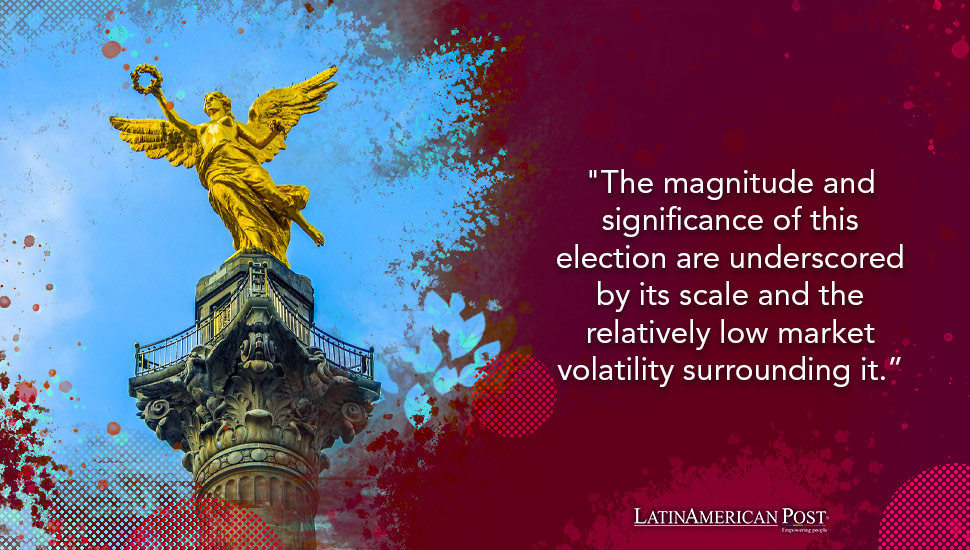Mexico Faces Historic Election with Economic Boost from Nearshoring

As nearly 100 million Mexicans prepare to vote in the June 2 general election, the country’s economy benefits from nearshoring and the USMCA trade agreement. Claudia Sheinbaum is leading the polls for the presidency.
On Sunday, June 2, Mexico will hold its largest-ever general election, with almost 100 million citizens eligible to vote. This historic event occurred when the Mexican economy experienced stability, largely thanks to nearshoring and the United States-Mexico-Canada Agreement (USMCA). Analysts agree that these factors have provided a solid foundation for the nation’s economic landscape as voters prepare to elect over 20,000 officials, including the next president, 500 deputies, 128 senators, and nine state governors.
The frontrunner in this election is Claudia Sheinbaum of the ruling National Regeneration Movement (MORENA), who is leading significantly in the polls against her main rival, Xóchitl Gálvez, from the opposition coalition Fuerza y Corazón por México. The current president, Andrés Manuel López Obrador (AMLO), will end his six-year term, and Sheinbaum, a close ally, is expected to continue his policies.
The magnitude and significance of this election are underscored by its scale and the relatively low market volatility surrounding it. Rodolfo Ostolaza, Deputy Director of Economic Studies at Citibanamex, described the election as atypical due to the stability observed in financial markets. “This presidential election is truly unusual because financial market variations have been negligible,” he told EFE.
Economic Stability and Growth
Despite a slowdown, with growth rates below 3% annually, Mexico’s economy remains stable, supported by the USMCA, which provides economic certainty. The Ministry of Finance forecasts a GDP growth rate between 2.5% and 3.5% for this year and 2% and 3% for 2025. Ostolaza noted that Mexico’s foreign solid reserves, a declining inflation trend, a robust labor market, historically low unemployment rates, and rising real wages contribute to this stability.
However, inflation has recently ticked up to 4.78%, prompting the Bank of Mexico to reconsider its interest rate cuts, currently at 11%. The Mexican peso, often called the “super peso,” is trading below 17 pesos per dollar, a level not seen in nearly a decade. The government touts this as evidence of the economy’s health.
Gabriela Siller, Director of Economic and Financial Analysis at Banco Base, pointed out that the Mexican government has been spending heavily, leading to a budget deficit of 5%. This fiscal pressure risks the country’s credit rating and will be a significant challenge for the next administration. Analysts agree that addressing this fiscal strain and continuing to attract foreign investment through nearshoring will be crucial.
Nearshoring, or relocating business operations closer to home markets, has become a key driver of Mexico’s economic growth. The country’s proximity to the United States, combined with the benefits of the USMCA, makes it an attractive destination for companies looking to optimize their supply chains.
Rodolfo Hernández Sada, Executive Director of International Business at Santander México, emphasized that the political and economic conditions are conducive to nearshoring. A report by JP Morgan echoed this sentiment, suggesting that the June elections are unlikely to cause market instability. However, the upcoming U.S. presidential election could create more volatility, against which investors should be prepared to hedge.
Historical Context and Political Implications
A complex history has shaped Mexico’s journey to its current political and economic state. The country has experienced significant transformations, from the Mexican Revolution in the early 20th century to establishing a one-party state under the Institutional Revolutionary Party (PRI). The turn of the millennium saw a shift towards multi-party democracy, culminating in AMLO’s victory in 2018, which marked a leftward shift in the country’s political landscape.
AMLO’s administration has focused on social programs, anti-corruption measures, and economic policies to reduce inequality. Sheinbaum, his chosen successor, is expected to continue these initiatives while addressing new challenges. Her primary opponent, Xóchitl Gálvez, brings a business-oriented approach, advocating for economic liberalization and investment in technology and infrastructure.
Despite the electoral excitement, Mexico’s financial markets have remained remarkably calm. The nation’s economic fundamentals, such as foreign solid reserves and a declining inflation trend, provide a buffer against potential volatility. However, the fiscal deficit and the global economic environment remain areas of concern.
The stability of the Mexican peso, dubbed the “super peso,” reflects investor confidence in the country’s economic policies and prospects. The USMCA has played a pivotal role in this stability, offering a framework for trade and investment that reassures markets.
Looking Ahead: Opportunities and Challenges
The next administration must balance the gains from nearshoring with the challenges posed by fiscal deficits and global economic uncertainties. Ensuring sustainable economic growth while maintaining social stability will be critical. Education, healthcare, and infrastructure investments will be necessary to support long-term development and improve living standards.
Moreover, the new government will have to navigate the complexities of international relations, particularly with the United States, Mexico’s largest trading partner. The outcome of the U.S. presidential election could significantly impact Mexico’s economic and political landscape, adding another layer of complexity to the new administration’s agenda.
The country stands at a crossroads as nearly 100 million Mexicans prepare to cast their votes. The outcome of the June 2 general election will determine the future direction of Mexico’s political and economic landscape. With Claudia Sheinbaum leading the polls, a high possibility of continuity in policies under a new administration exists.
Also read: What to Know About Mexico’s 2024 Presidential Election
The stability provided by nearshoring and the USMCA has positioned Mexico well, but the next administration must address fiscal challenges and continue attracting foreign investment. The election’s results will have far-reaching implications for Mexico and its role in the broader Latin American context.
This election represents a critical moment in Mexico’s democratic evolution, reflecting the country’s progress and the challenges ahead. As the world watches, the choices made by Mexican voters will shape the nation’s future and its place on the global stage.





